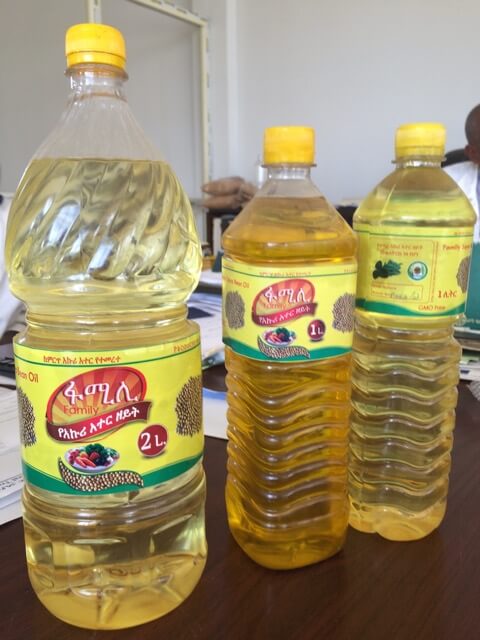To Refine Or Not To Refine…

Photo: Fully-refined ExPress® soybean oil bottled and ready for shipment to supermarkets in Ethiopia. Insta-Pro customer Kunifira Agro Processing chose to install a 3 ton per day refinery to complement its 1 mt/hr ExPress® plant.
As more and more feed companies, poultry integrators and independent processors install small-medium scale ExPress® plants in the 1-10 mt/hour range, the question arises of what to do with the oil.
There is always the simple option of selling crude vegetable oil to a local refiner or feed mill, but in markets where the value of bottled retail oil can be 3 times that of bulk crude vegetable oil, processors may want to capture that extra value and sell ‘refined’ oil in bottles.
The first and fundamental point about ExPress® crude vegetable oil is that it is fit for human consumption straight out of the press. That’s because it has been naturally pressed out of the seed, without solvents, chemicals or even steam. In some countries, crude ExPress® soybean oil is prized as skin and hair oil, because it’s so pure and natural.
But other considerations have to be taken into account. Food regulations often require vegetable oil sold to consumers to be ‘RBD’ – refined, bleached and deodorized. This is a hangover from an age when most vegetable oils were processed with solvents, notably hexane, and it was imperative to refine out all traces of this chemical. Government regulations don’t distinguish between mechanically processed oil and solvent processed oil.
So what are the major refining steps and what are the options for ExPress® processors?
Step 1: Clarification or Filtering. Crude vegetable oil coming off the press contains some solids – small particles of meal. We use a filtering method to remove these particles. The lowest cost method is a settling tank where the solids slowly sink to the bottom of the tank and clear oil is pumped from the top. This method is time-consuming and the tank has to be cleaned out from time to time, but it is still effective. Insta-Pro’s screening tank is an intermediate solution: a continuous mechanical screening apparatus that removes about 97% of the solids (these are put back into the meal, as they are rich in nutrients). A centrifuge, also called a decanter, is the most efficient method for clarifying oil, removing 99.98% of solids in a high-speed process, but the cost is hard to justify for plants under 4 mt/hr.
Step 2 Degumming. Gums cause oil to foam during deep frying, so it’s considered preferable to remove them. Crude degummed soy oil is the internationally traded oil standard, meaning that it can be sold anywhere. Degumming requires the addition of a small amount of water to the oil, causing the gums to agglomerate. A decanter-centrifuge is then used to separate the liquid and solid fractions by centrifugal force. With our oil-refining partner we are presently developing a compact, skid-mounted degumming unit, specifically designed for use with small-scale ExPress® plants. Degummed ExPress® soy oil may be used in all food applications, including deep frying. It has a rich golden color and distinctive nutty flavor.
Step 3 Full Refining. The crude degummed oil is bleached, a variety of components are removed and finally the oil is deodorized. The result is a bland-tasting and almost colorless ‘refined’ oil.
ExPress® soybean oil is naturally rich in nutrients, such as vitamins and tocopherols (antioxidants). It is also very stable with a long shelf- and frying-life. Studies by USDA’s National Center for Agricultural Utilization Research have shown that physically refined ExPress® soy oil has significantly better oil frying stability and better flavor quality that solvent-extracted oil. This oil is preferred by many chefs and restaurant owners.
To learn more about ExPress® oil stability, see Dave Albin’s blog. To review your options and the costs involved, please contact your Insta-Pro sales manager. We are here to assist.



